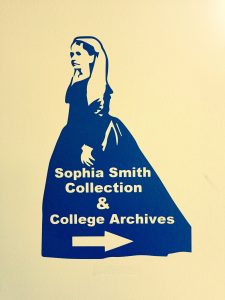
Sophia Smith Archive Collection Sign
Box 493: This box has a lot of different resources, more so than the other three boxes in the collection. All of the documents in this box are from the national chapter, not states. The first few folders give information about the Subcommittees and YWCA meetings that discussed rights of employers and employees. These documents have input from both of these groups. The folder titled “Bibliographies” has citations of essays and written works about household work, household employment, household management, etc. Several other folders include legislation, placement and unionization which include bills and acts as well as correspondence between the YWCA and Washington offices. There is a small folder titled “Negro” in this box that gives information about black women working as domestic workers, the unemployment crisis of black domestic workers as well as the difficulties in placing black women. The last few folders deal with the Subcommittee on Household Employment from the National Board. These folders include correspondence between chapters as well as publications regulating employee/employer relations.
Box 494 and 495: These two boxes contain documents from different state Subcommittees. Box 494 holds information about each state’s chapter from California to New Jersey and 495 holds New York to Wisconsin. These folders contain correspondence between state chapters with the national YWCA chapter as well as contracts put forth by the states to mediate employee/employer relations. Some of these states, see the Chicago folder, have publications and books with information on how to negotiate with employers for things like time off, reducing hours, responsibilities, etc.
Box 496: This box contains documents discussing employer-employee relations in the home. There are documents from the 1928 conference discussing relations in the home (See section 2 of this toolkit). The two first folders state “National Committee on Employer-Employee Relations in the Home” which was the original name of the NCHE. The documents are write-ups from the conference discussing ways to improve relations on the part of the employers as well as the employees. The folders in this box span from 1928-1936, tracing the trajectory of the organization and the conferences it had each year. There are also resources produced by the NCHE in this box. There are several booklets for employees and employers on how to navigate their relations and in the final folder, there is one booklet publicizing demands of domestic workers.
